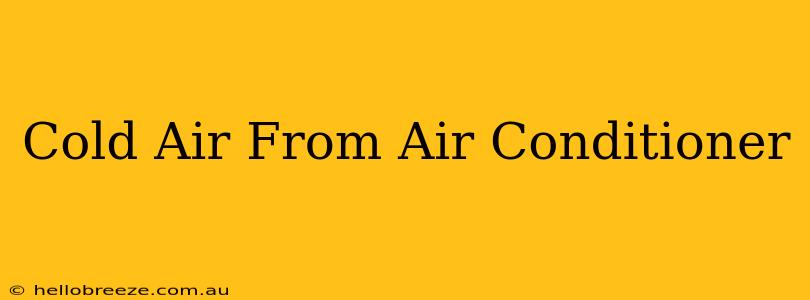Is your air conditioner blowing cold air? That's great news! But what if it's not blowing cold air, or not cold enough? This comprehensive guide will help you troubleshoot common problems and maintain your AC unit to ensure a consistently cool and comfortable home.
Understanding Your Air Conditioner's Cooling System
Before diving into troubleshooting, it's helpful to understand the basics of how your AC system works. It's a closed system involving refrigerant, which absorbs heat from your home and releases it outside. This process relies on several key components working together:
- Refrigerant: The substance that absorbs and releases heat. Low refrigerant levels are a major cause of insufficient cooling.
- Compressor: This powerful component compresses the refrigerant, raising its temperature and pressure. A faulty compressor can significantly impact cooling performance.
- Condenser Coils: These coils release heat from the refrigerant to the outside air. Clogged coils reduce efficiency.
- Expansion Valve/Metering Device: This regulates the flow of refrigerant. Problems here can restrict or over-supply refrigerant.
- Evaporator Coils: These coils absorb heat from inside your home, cooling the air. Dirt and debris can significantly reduce their efficiency.
- Air Filter: This crucial component filters out dust and debris, preventing them from clogging the evaporator coils. A dirty filter restricts airflow, reducing cooling capacity.
Troubleshooting Problems with Cold Air Output
If your AC unit isn't blowing cold air, or the airflow is weak, here are some common problems to check:
1. Check the Air Filter
This is the easiest and most common fix. A dirty air filter restricts airflow, forcing your system to work harder and potentially reducing its cooling capacity. Replace your air filter every 1-3 months, or more frequently if you have pets or allergies.
2. Inspect the Condenser Coils
Located outside, these coils can become clogged with dirt, leaves, and debris, hindering heat dissipation. Clean the coils with a garden hose or coil cleaner, following the manufacturer's instructions. Never use a pressure washer, as this can damage the fins.
3. Examine the Evaporator Coils (Often requires professional help)
Located inside, these coils are harder to access. They can also become dirty, restricting airflow. While you might be able to visually inspect them, professional cleaning is usually recommended.
4. Check the Refrigerant Level (Requires professional help)
Low refrigerant levels are a major reason for poor cooling. This requires a professional HVAC technician to check and recharge the system, as handling refrigerant is dangerous and requires specialized equipment.
5. Assess the Blower Motor and Fan (Requires professional help)
A faulty blower motor or fan can reduce airflow. A professional technician can diagnose and repair or replace these components.
6. Investigate Electrical Issues (Requires professional help)
Problems with wiring, breakers, or the capacitor can affect the system's performance. Consult a qualified electrician or HVAC technician for these issues.
Maintaining Your Air Conditioner for Optimal Performance
Regular maintenance is crucial for ensuring your air conditioner blows consistently cold air and prolongs its lifespan. Consider these tips:
- Regular Filter Changes: As mentioned, this is paramount.
- Annual Professional Inspection: A yearly check-up by an HVAC technician helps identify and address potential problems before they escalate.
- Keep the Condenser Unit Clear: Regularly remove debris from around the outdoor unit.
- Proper Ventilation: Ensure adequate airflow around the unit.
By following these troubleshooting steps and maintenance tips, you can keep your air conditioner blowing cold air all summer long, ensuring a cool and comfortable home environment. Remember that for serious issues, such as refrigerant leaks or electrical problems, it's crucial to call a qualified HVAC technician. Don't attempt complex repairs yourself unless you have the proper training and experience.

